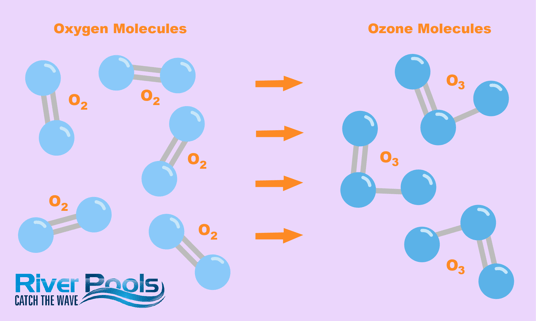What is Pool Ozone? How It Works, Cost, Pros, and Cons
Updated: March 11th, 2025 | Published: April 17th, 2020
5 min read
By Jason Hughes

If you think that ozone is a mysterious substance that only exists miles and miles up in the stratosphere, think again!
Ozone plays an important role in protecting us from the sun, but did you know that it can also protect you from harmful pathogens in your swimming pool?
Don’t worry, you won’t have to siphon ozone from the ozone layer in the sky to get it. In fact, you can make ozone right in your own backyard.
At River Pools, we specialize in manufacturing fiberglass swimming pools, and over the years, we’ve seen a wide range of pool sanitation methods. Ozone is one method that can be useful in both indoor and outdoor pools and spas, but is it right for you?
By the end of this article, you should have a better understanding of how pool ozone works, how much it costs, and some pros and cons of using it in your swimming pool or spa.
What is Pool Ozone?
Ozone is a blue-colored gas that’s made up of three oxygen atoms. Ozone is useful in swimming pools because it effectively kills and inactivates bacteria, parasites, and viruses. It's also a good oxidizer, which means that it can chemically destroy contaminants in the water.
You do not add ozone directly to the pool. Instead, a machine called an ozone generator injects ozone into the pool's circulation system. When your pool water passes through it, the ozone sanitizes it before returning to the pool.
Once the circulated, sanitized water is returned to the pool or spa, ozone is present at a very low and safe concentration, if at all. Because it does not maintain a residual disinfectant, another chemical, like chlorine or bromine, should be added to the pool to ensure that the water is completely sanitized and safe for swimming.
Ozone is unstable and untransportable, meaning you can’t buy it in tanks like you can with other gaseous chemicals. It must be generated on-site using an ozonator or ozone generator.
Let’s explain how a pool ozone generator works.
How Does a Pool Ozone Generator Work?
Ozonators, or ozone generators, are installed in the pool’s circulation system downstream from the operating equipment. As the water passes through the ozonator, it gets sanitized by the ozone before returning to the pool. Because ozone is not safe for humans, all or most of the ozone should be used up before the treated water is returned to the pool where it will come into contact with swimmers.
Keep in mind that your local or state health regulations may also require you to install an ozone detection system as an added precaution.
Another thing to keep in mind is the placement of your pool ozone generator. Any time you install and use an ozonator, it needs to have access to fresh air, and it cannot be underground.
Ozone is usually generated by one of two methods: corona discharge or ultraviolet light. Both methods break apart regular oxygen to make ozone, just in different ways. Let’s briefly explain how these generators work.
Corona Discharge Ozonator
A corona discharge ozonator (also known as a corona discharge generator or CD ozone generator) uses high voltage electrical discharges to create ozone. It sounds complex, but the science is actually pretty simple: the electrical discharges create a ring of energy, and as air flows through that ring, some oxygen molecules get split apart and reassemble to form ozone.

One thing to note is that it’s important for all moisture to be removed from the air before this process can take place. Your ozone generator will likely have an air dryer for this purpose. According to the National Swimming Pool Foundation, if the moisture isn’t removed first, nitric acid can form in the generator, which can interfere with ozone production and harm the equipment.
UV Ozonator
A UV ozone generator is a second method for producing ozone to disinfect your swimming pool. For ultraviolet light to turn air into ozone, air needs to be passed over UV lamps that emit light at 185 nanometers.
As the air passes over these lamps, the energy splits the oxygen molecules and then they reassemble into ozone molecules. It's like how sunlight can change your skin color, but these lights change oxygen's structure instead.
Remember, oxygen contains two oxygen atoms and ozone contains three. When the oxygen molecules split apart, they attempt to stabilize, forming ozone in the process.
Once the ozone is generated (using either type of generator), it needs to be dissolved into the water. The most common method is venturi injection. This occurs when the pool water rushes through a narrow part of the pipe and creates a sucking effect that pulls ozone into the pool water and mixes it in really well. This is how the ozone gets dissolved into your pool water efficiently.
-1.png?width=792&height=250&name=Screenshot%20(67)-1.png)
Venturi Injection Process
Corona Discharge vs UV Ozone Generators
Both types of ozone generators do the same thing in terms of scrambling the oxygen atoms to produce ozone. However, they differ in a few key ways. First, corona discharge generators produce a higher concentration and quality of ozone than UV generators.
Keep in mind that CD generators are more expensive to buy and install, but they produce ozone at a cheaper rate.
Maintenance will also be different for each, so be sure to research each of your options before making your final decision.
Ozone Pool System Cost
Pool Ozone Generator Cost
The price of a pool ozone generator can vary widely by brand, but one thing is pretty much always true: the more gallons of water that are in your swimming pool, the more you can expect to pay. This price can range from several hundred dollars to several thousand, with spa ozone generators being the most affordable.
Swimming Pool Ozone vs Chlorine
Although ozone and chlorine are both pool sanitizers, comparing them is kind of like comparing apples and oranges. Instead of pitting ozone and chlorine against each other, it might be a better idea to try using them together. In fact, they make a pretty good team.
If you use chlorine on an indoor pool, for example, an ozonator can offer another advantage to help you out in balancing your pool water chemistry. Ozone breaks chloramines, reducing combined chlorine levels, which can cause skin nad eye irritation. This can go a long way in improving the air quality in indoor swimming pools.
Ozone also works well with bromine in pools and spas as a supplemental disinfectant and oxidizer. As you might remember from our article comparing bromine vs chlorine, bromine breaks down faster when exposed to sunlight or artificial UV light, but ozone won’t have this effect on bromine.
Ozone Pool System Pros and Cons
Now that you know how ozone pool systems work, let’s get into a final list of pros and cons to help you decide if it’s right for your swimming pool or spa:
Pros
- Works with inground, above ground, indoor, and outdoor pools
- Works with fiberglass, vinyl liner, and concrete pools
- Multiple options (CD and UV generators)
- Effectively kills and inactivates bacteria, viruses, and parasites
Cons
- Ozone is dangerous for humans and needs to be carefully contained
- Ozonators can be expensive to buy and install
- Acts as a supplemental sanitizer and oxidizer only (you will need additional chemicals like chlorine or bromine)
At River Pools, we manufacture fiberglass pools for customers across North America. If you're interested in a fiberglass swimming pool for your home, take a look at our catalog of models and see our fiberglass pool gallery for more ideas.
Want to know how much your fiberglass pool might cost? Contact us today to request pricing, and in the meantime, try out our pool pricing calculator for a fast estimate:

Want to see about how much that cost will be with all your favorite pool accessories?
Use our Design and Price Tool to walk through your options and approximate price!
If you're still looking for the right inground pool, be sure to download our free ebook below which takes an in-depth look at the three main inground pool types.
Up Next:
Inground Pool UV System: Cost, Pros, Cons, and How It Works
What is a Natural Pool? Filtration, Costs, and Pros and Cons
Jason Hughes is a partner at River Pools Virginia, a fiberglass pool installation company based in Warsaw, Virginia. With over 20 years of hands-on experience, Jason has dedicated his career to helping families create beautiful, functional backyards while ensuring every fiberglass pool installation meets the highest standards of quality and safety. In addition to his work with homeowners, Jason serves as a GENESIS instructor with the Pool & Hot Tub Alliance (PHTA), where he teaches fiberglass pool installation best practices to pool professionals across the country. Whether he’s on a job site or leading a training session, Jason is passionate about raising the bar for fiberglass pool installations and helping families make confident, informed decisions as they transform their outdoor spaces.
Topics:


